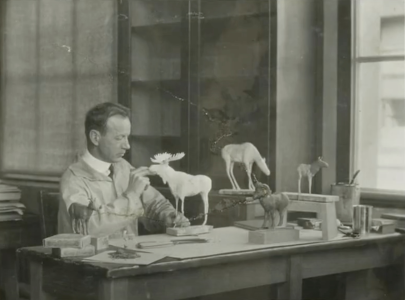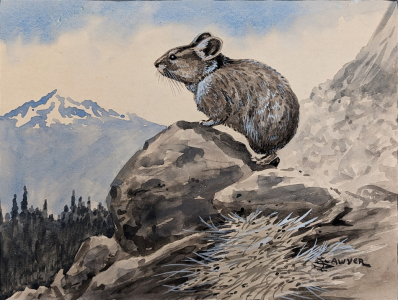
Biography
Edmund J. Sawyer's Post Office mural in Dennison, OH is unique among all the murals commissioned by the Section of Fine Arts: its subject is Passenger Pigeons. At the time he painted this mural, Sawyer was 60 years old and had gained a reputation as the Dean of American Bird Artists.
His path to this title is an interesting one - and very personal. He was orphaned at an early age, when his mother died shortly after his birth and his father, a member of the Coast Guard, was drowned in a squall. He was raised by his father's sister. Family friends remember him entertaining them with sketches of birds on a wire. And he told the story of a schoolteacher who assigned her class an exercise: list as many birds as you can, and describe aspects of each one. Edmund's effort was ridiculed by his teacher, since he had listed only one bird - a robin. What the teacher somehow missed was that Edmund was able to come up with a complete description of the robin's habits and habitat - not from having read about it but from his own personal explorations. And, given time, he could have described dozens of other birds at the same level of detail. Not surprisingly, this incident marked the end of Sawyer's formal education.
In 1907 Sawyer married Ellen May Town, a classically trained pianist. They had three children in short order, and the 1915 census lists him as a "bird artist." During the years 1910-1919, Sawyer and his wife lived in Watertown, NY, and Sawyer studied birds in the Ellisburg and Dexter swamps, publishing his drawings and paintings in "Bird Lore" magazine. The Watertown Bird Club printed his monograph "Land Birds of Northern New York" in 1916.
By 1920 Sawyer's wife may have tired of their hand-to-mouth existence, and the couple separated, with Ellen taking the three children. Sawyer traveled west, and in 1924 he was appointed chief naturalist at Yellowstone National Park, a position he held through 1928. During this period he started the Park publication "Yellowstone Nature Notes" and created 9,000 sketches of birds while publishing in hundreds of magazines. In 1930 he was back in New York State, with a census listing as "Artist, Bird Ornithology." He married Helen Gage Bottum, a nurse, in 1936 and held a temporary job at the Cornell Department of Ornithology.
His Dennison Post Office mural was painted in 1940, after which he moved to Kirkland, WA. During the war he and his wife worked for the Army as spotters on Copper Mountain in the North Cascades. In 1956 he moved to Vashon Island, where he died in 1974. He was the author of many books relating to birds, and was known on Vashon as the "Bird man of Vashon Island."


Critical Analysis
It is striking to compare Sawyer's sketches and paintings. The paintings typically show a precise image of the animal being depicted, with a background that tends toward monotone and softer focus. In the sketches, there is less polish in the drawing but a nervous energy that somehow matches the energy of a living bird. Perhaps the sketches express more of the boyhood wonder that must have drawn Sawyer to this art form in the first place.
Murals
- Dennison, Ohio - Post Office: Passenger Pigeons
References
- Edmund Joseph Sawyer (Bluebird Housing).
- Edmund Sawyer (askART).
- Edmund Sawyer: Naturalist, Ornithologist, Artist.
- EJ Sawyer - great grandfather (Michelle).
- Original artwork by Edmund J. Sawyer (Unexpected Wildlife Refuge).